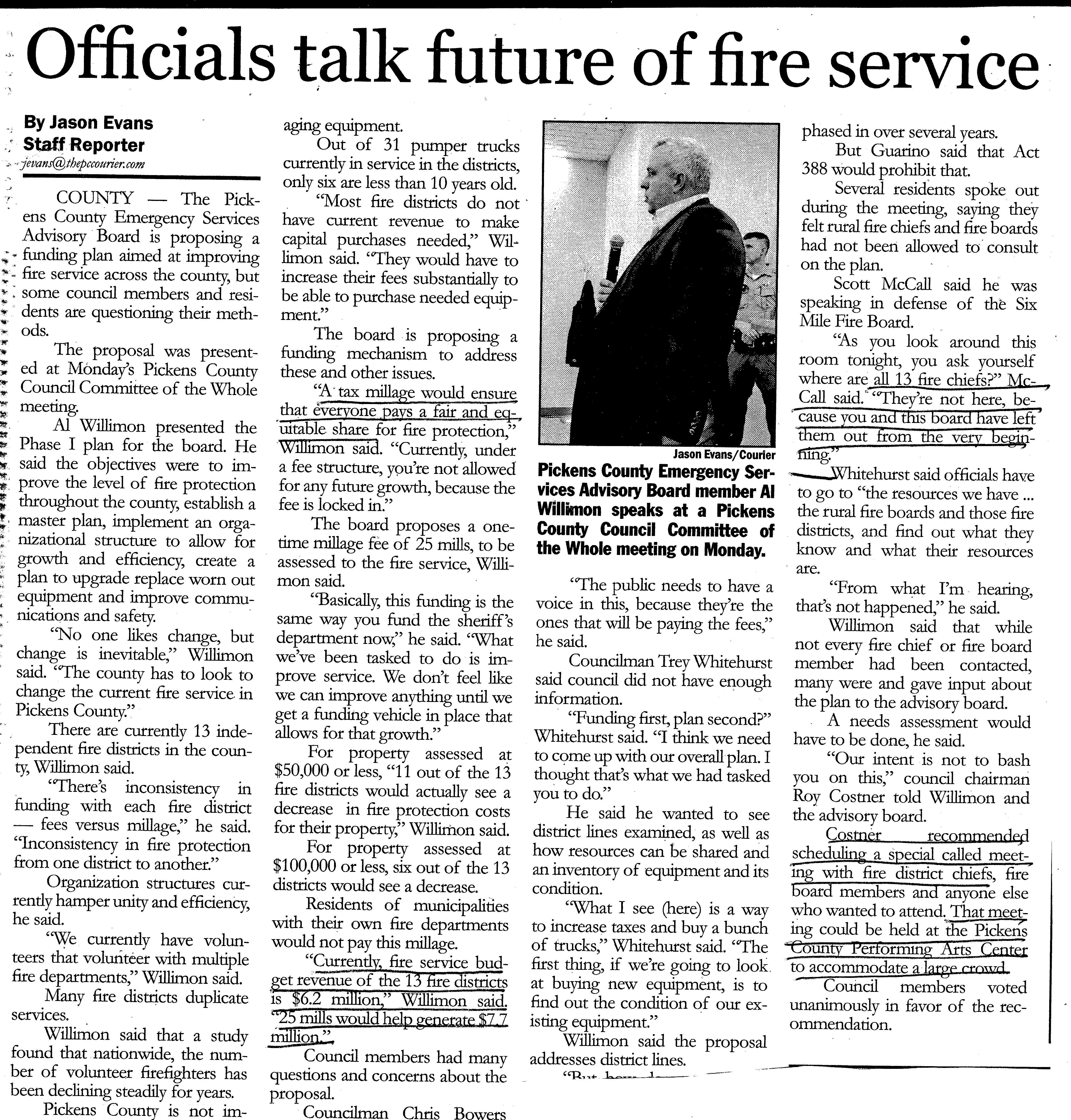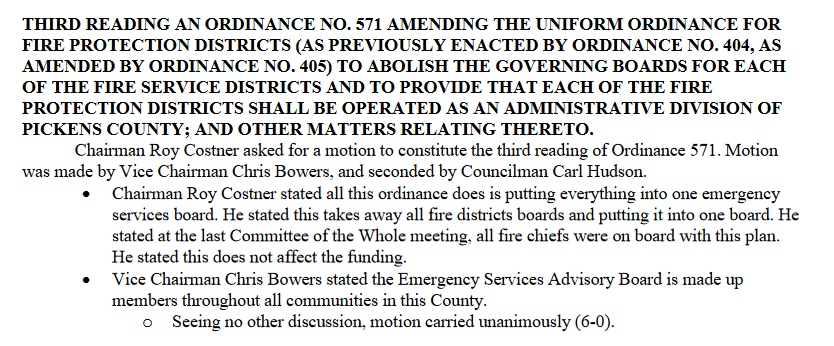Overhauling Fire Protection
By Alex Saitta
December 15, 2019
Introduction:
Public participation is vital for our local democracy and the public needs to know both sides of the issues if it is going to help steer solutions and make an informed vote. Unfortunately, government often just puts its best foot forward, tells the public half the story or only what it wants the public to know. Whether it is the newspapers or concerned citizens like myself, at times someone has to shine additional light on the subject in order for the public to hear both sides of the story. This is another one of those instances Ė changes coming to fire services in Pickens County.
New Plan:
Over the past year the county council and county administration discussed and county officials proposed a plan to radically change the structure of fire protection in Pickens County. For decades we had 13 local fire districts, with a chief and a citizenís board for each district. Most districts charged only a fire fee on houses and a few charged millage on all property.
Their proposal is to abolish all the 13 fire boards, have one centralized board, the county to take ownership of all fire equipment and charge a 30 mill fire tax on all property. The benefits they site are centralized management, streamline operations, build a comprehensive capital plan, more manpower and better training. They also say it will save money, but looking at the proposal that is not true and they need to be upfront and honest with the public on the high cost, fees and taxes. The first year costs rise from $6.2 million to $7.7 million. I counted more than 10 new spending initiatives in the proposal.
County Council:
The county council approved the first part of the plan 6 to 0 by eliminating the citizen fire boards, and taking ownership of all fire equipment owned by the individual departments. That is, all those sitting on the fire boards were dismissed and the 13 local fire boards were dissolved. Now there is one county wide fire board.
The council has not voted on the rest of the plan.
I think the council supports the overall plan, but realize the public will never support its 30 mill fire tax on all property. Thatís $120 for every $100,000 owner occupied home. A $180 for every $100,000 rental property. And who owns a home that is only worth $100,000, so your fire tax will likely be more. That millage rate will also be slapped on your vacant land, cars, boats, RVís, motorcycles, business building and equipment.
Add in a less responsive board, more central control, the ability of the county to play Robin Hood with equipment, transfer employees all over, and the council has put the rest of the plan on the back burner until after their 2020 re-election.
Two Points Of View?
Looking beyond this issue, the overall problem is clear Ė the council suffers from group think. The direction is set and plans are formulated by the council leadership and the administration, and for the most part the rest of the council just goes along and votes for what is placed in front of them. They may not all swallow the details of every plan and they discuss those, but they go along with the overall direction set by the administration and the chairman and their plans. The voting record of this new council going back to January 2017 shows this, and this issue demonstrates it.
If this was truly an independent council, with members representing the variety of views of county citizens and interests, there would have been at least two points of view brought forward on this issue: one viewpoint would have advocated this new one board/ centralized control system, and the other viewpoint would have defended the old 13 board/ locally controlled systems. Both plans would have been critiqued and debated publicly by the council.
That never happened and really this is my overriding point in this write-up. A lack of true and honest debate.
One, no councilman put forward the viewpoint of the existing fire board members and all those who supported the old system. The old system has merits and many advantages.
Two, to squash the debate of the old system vs. the new system, last year the administration told the fire boards the decision was already made, the boards would be eliminated, the boards were stripped of their authority and the reappointment of board members was curtailed. By the way, in 2018 the council voted to remove one fire board member who spoke out against the new system.
In sum, the starting point by the administration and council leadership was the current system would be ended. I do not doubt the committee put a lot of time into their effort(I read the 2 committee reports), but it was from that starting point that the current system would be ended. Dumping the current system was pre-determined by the administration and council leadership, the old system was undermined and its merits and how it could be improved were not debated, and the rest of the council just went along with it. .
Letís Drill Down On This Plan:
The county officials argue their plan will improve fire protection, make fire services consistent across the county, would upgrade equipment and allow stations to more readily share resources.
OK, if this was truly debated, the first question asked and debated would have been, what is wrong with the old system of fire protection? The county officials said the old system had flaws, but didnít present any numbers I could see. Before the council radically changes the system, it should show the numbers where there is a need that is not being met.
Second, see if the current design could better use the existing resources to meet the need. Third, if they are still short, then think about more funding. Fourth, if that was not possible or didnít work, then think about overhauling the structure. All that was missing here.
Liberty Take Over:
You donít need a crystal ball to see what is going to follow. All you have to do is look at the county takeover of the City of Liberty fire protection.
The city of Liberty was spending more money than it was bringing in for years, resorting to a financial shell game to ďbalanceĒ their budget each year that ultimately caught up to them. The county government then came in and bailed out the city by taking over city fire responsibilities and fire costs and fees went through the roof for both to city and county residents in Liberty.
In 2016 city residents paid the county government 61 mills in property taxes, 80 mills were also paid to the city and they received fire protection from the city. Then the county took over the city fire protection, and the city shed that cost. In 2017 the city residents paid the 61 and 80 mills again, PLUS a new $120 fire fee per home on top of that.
The Liberty residents who live just outside the city, but are considered in the Liberty rural area (and they had nothing to do with the financial woes in the city of Liberty), their fire fee on their house rise from $106 to $120.
In 2019 the residents in the city of Liberty are paying 84.3 mills to the city, plus 61 mills to the county and a fire fee of $156 per house. And those Liberty residents living in the county are paying $156 too.
Six Mile and Pickens Fire:
The county also took over fire protection in Six Mile. More expensive and they need to be upfront and honest about that, as this will be the rule rather than the exception going forward.
In 2016 the fire fee in for the residents in the rural area surrounding Six Mile was $65 per home. The Six Mile town residents received fire protection as part of their 33.5 mill property tax. When the county took over fire protection, the fee per house for rural residents rose to $100. The residents of Six Mile are still paying the 33.5 mill city tax, plus another $100 per home for fire protection.
In 2014 the fire fee in rural Pickens was $75 per home, and the city of Pickens residents had fire protection included in its 60.3 mill property tax. Then the county took over the fire protection of rural Pickens, and in 2019 rural residents paid $140 (it will be $175 in 2020). The residents of the city of Pickens pay the city property tax of 78.3 mills, plus another $125 for fire protection.
There are three examples when the county got involved with fire protection, the cost went up significantly. Sure they are providing more services, but the cost will be higher.
More Details:
The county officials also argued their plan would lower fire ISO ratings and hence lower home ownersí insurance rates. I have heard this argument for 15 years now, in support of every new initiatives when it comes to fire protection. Again, I never saw evidence presented that it lowered insurance costs county wide. I own 13 homes around Pickens County. Not one year has my homeownersí insurance fallen.
What happens in the case of the Vineyards that willfully through their local board paid 51 mills for fire protection this year? Will their rate drop to 30 mills? If so, will they get the same high level of service, or will their fire service be cut significantly?
Under the old system with a local Vineyards fire board, if they wanted all that fire service, they got it if they choose to pay for it, and they didnít have to fuss with a centralized board or county wide bureaucracy.
My Opinion:
Most like the local citizen fire boards and the flexibility and choices this gives a local fire district. For instance if those living in the XYZ area want to have 3 fire engines, but those living in the ABC area want just 2 and an extra tanker truck, they both have that choice under the old system.
If those in XYZ want a millage rate on all property and ABC wants a fire fee for houses only, they both have the choice under the old system. Heck if ABC wants to charge small house $xxx and large houses twice that, they could.
Every member on the local fire boards lived in the district and hence returned phone calls and listened to what local citizens had to say. With the county wide board, one of the members lives in your district. Thatís it. A centralized board is less responsive to the people and more directly controlled by the county administration.
Whatever the answer to those questions, I do not support changing the structure from local control to the new system of centralized control.
My Solution:
Keep the local fire boards, local chiefs and individual districts. However, make the citizen board members run in the November election like everyone else every 4 years. This will make the local boards more responsive to the public need and financing.
Give the local boards the authority to draw up and approve budgets, set millage or fees and the chief reports to the board and set millage or fees. It will be up to the elected and accountable to the public fire boards. A government directly responsible to the people.
If this or that district has a need, let the board elected by the people in November satisfy it, as opposed to turning the entire system over to a centralized bureaucracy that will surely cost more and be less responsive to the people in the long run.



